Subcontracting Concurrent Programs
This chapter covers the following topics:
- Overview of Subcontracting Concurrent Programs
- Interlock Manager
- Reconciliation Manager
- Auto Receive Components
- Process Receiving Transactions
- Processing Logic
- Remove Allocations
Overview of Subcontracting Concurrent Programs
Subcontracting concurrent programs are common to discrete manufacturing, seiban-based manufacturing, and process manufacturing. These sections describe the following subcontracting concurrent programs:
Interlock Manager
Interlock Manager is a concurrent request that should be run immediately after running the ASCP plan and transferring the planned orders for outsourced assemblies and subcontracting components to Purchasing. Interlock Manager picks up the subcontracting orders and replenishment purchase orders and performs the following:
-
Creates discrete jobs for assemblies and replenishment purchase orders for synchronized components in the MP organization.
-
Creates replenishment sales orders for prepositioned and synchronized components in the OEM organization only if the supply type is Assembly Pull or the supply type is Push for lot controlled components in an external MP organization.
Note: Components with supply type as Supplier Supplied, Phantom, and Bulk will be ignored as they do not require replenishment. Operation pull is not supported.
For multiple synchronized components in an assembly, Interlock Manager creates one replenishment purchase order with multiple lines for the synchronized components. On the basis of this replenishment purchase order, Interlock Manager creates a single replenishment sales order with multiple lines for the synchronized components.
For multiple prepositioned components in an assembly, when ASCP creates replenishment purchase orders or you create replenishment purchase orders manually, you can:
-
Create one replenishment purchase order (RPO) with multiple lines for each prepositioned component. On the basis of this single replenishment purchase order, Interlock Manager creates one replenishment sales order with multiple lines corresponding to each prepositioned component.
-
Create separate replenishment purchase order for each prepositioned component. On the basis of each of the separate replenishment purchase order for each component, Interlock Manager creates separate replenishment sales order for each prepositioned component.
-
-
Allocates the replenishment sales orders to the corresponding subcontracting order to meet the component requirements at the partner's facility.
-
Defaults subinventory for synchronized common components during PO receipt by identifying whether a purchase order is a replenishment purchase order using item, supplier, supplier site, and ship-to location values and then using a custom API to derive and update the sub-inventory in RPO distributions.
Note: A common component is one that is used both in the outsourced manufacturing process and the normal manufacturing process at the internal MP location.
Attributes of Interlock Manager
Selection of Subcontracting Orders for Processing
Interlock Manager processes the subcontracting orders only if the following conditions are satisfied:
-
The MP organization can be WMS and EAM enabled.
-
Process-enabled organizations are also supported for full outsourcing with external manufacturing partners only.
-
For external MP organizations, serial controlled outsourced assemblies or components are not supported. Both lot and serial controlled outsourced assemblies or components are supported for internal MP organizations
-
For full outsourcing with external MP in process enabled organizations, the Interlock Manager creates the production batches for the outsourced product corresponding to the subcontracting orders created in the OEM organization.
-
Inventory periods are open in the MP organization.
-
WIP parameters are defined in the MP organization for discrete manufacturing organizations.
-
Process execution parameters are defined in the MP organization for the process enabled organizations.
-
Allocations are required for the proper planning, execution, and simulation of the manufacturing process at an MP site. Allocations refer to the designation of replenishment sales orders to the respective subcontracting orders to meet the component requirements for manufacturing the assembly at the MP's site. In Chargeable Subcontracting, although the components are shipped, the OEM retains ownership. When the OEM receives assemblies from MP, it is assumed as though the components are brought back from the MP when the OEM receives the assemblies. To support this practice, the sales price of the components shipped or to be shipped needs to be the same as the current list price. Also, the purchase price of the assembly includes the sales price of the components. Including the sales process is necessary in order to track the component consumption at the MP by the sales price of the components.
When Interlock Manager makes allocations, it validates based on two conditions:
-
Shipped components are available in the MP when the assembly is ready to be manufactured (replenishment sales order shipment date and the in transit lead time from the OEM to the MP is less than the discrete job start date).
-
For Chargeable Subcontracting, sales price of the components shipped or to be shipped is the same as the current list price.
-
In project manufacturing organizations, allocations for the subcontracting orders are also created based on component requirements in the corresponding work orders. If the component requirement for a component has a locator referenced with project and task, a replenishment sales order line with the same project and task reference is allocated to the subcontracting order. On the other hand, if the component requirement for a component has a locator without any references to a project and task, a replenishment sales order line without any project and task reference is allocated to the subcontracting order.
When all these conditions are satisfied, Interlock Manager allocates the replenishment order to the subcontracting order.
Subcontracting Sales Orders Creation for Outsourced Assemblies in Internal MP Organizations
In internal MP organizations, once the assembled item has been manufactured against the WIP job or Flow Schedule, it needs to be shipped to the OEM organization. A subcontracting sales order document is required against which the assembled item can be shipped.
The Subcontracting: Interlock Manager, creates a Subcontracting Sales Order in the MP organization linking to the Subcontracting Order created for the outsourced assembly in the OEM organization. This enables the end to end traceability of the material movement across the OEM and MP organizations.
Subcontracting: Interlock Manager creates a subcontracting sales order for an outsourced assembly in the internal MP Organization to enable shipment of the outsourced assembly from internal MP organization to the OEM organization after the completion of the manufacturing of the assembly in the MP organization. While creating the subcontracting sales order following are the mandatory fields that default:
-
Customer/Customer site – from the customer/supplier relationship defined in Customer/Supplier Association in Additional Organization Information.
-
Order type – from the shipping network.
-
Price list – from customer master.
-
Warehouse – MP organization.
-
Schedule Ship Date – Need by date on Subcontracting Order and Shipping Lead Time in shipping network. This will also be the completion date on the work order.
Additionally, Outsourced Manufacturing provides the ability to peg the work order to the subcontracting sales order in internal MP organizations. This pegging is achieved:
-
For Discrete Jobs, by reserving the work order to the subcontracting sales order in the Internal MP organization for all the items.
-
For Flow Schedule, by setting the sales order line status to Production Open for all the items.
To run Subcontracting: Interlock Manager
-
From the Subcontracting responsibility, navigate to the Requests window.
-
Use the list of values in the Name field, to select Subcontracting: Interlock Manager.
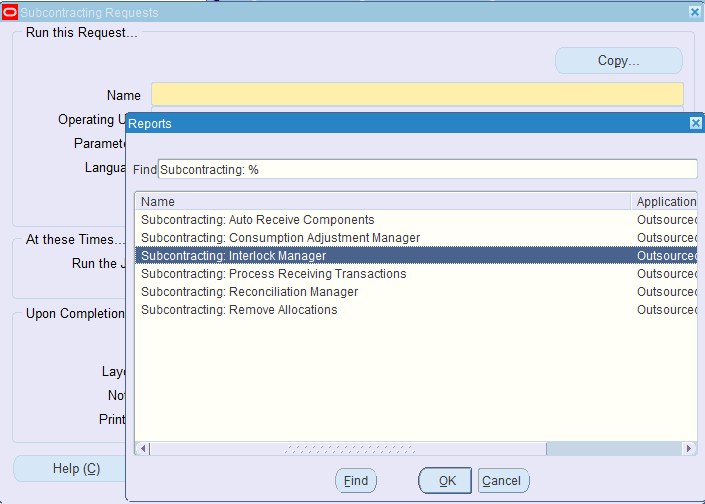
-
Click OK. The Parameters window appears.
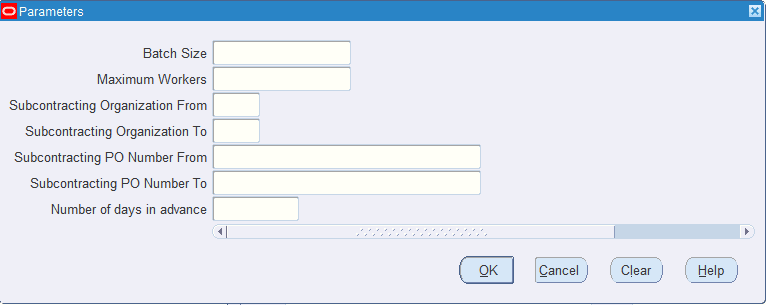
-
Enter the optional parameters:
-
Batch Size
-
Maximum Workers
-
Subcontracting Organization From
-
Subcontracting Organization To
-
Subcontracting PO From
-
Subcontracting PO To
-
Number of days in advance
-
-
Click OK.
-
Click Submit in the Subcontracting Requests window to run Interlock Manager.
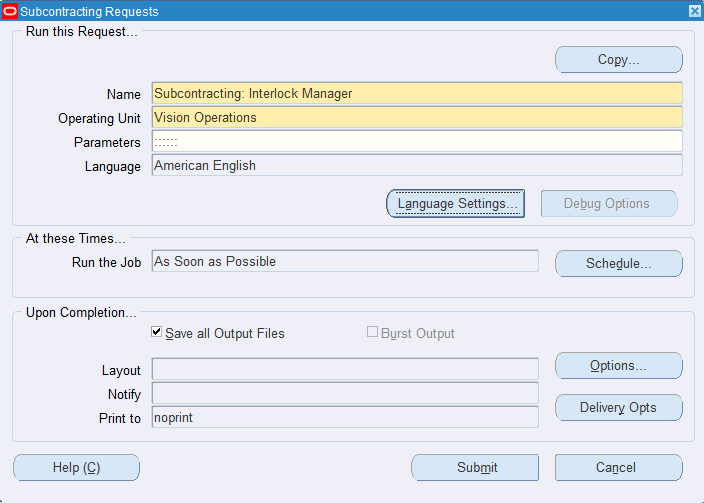
Reconciliation Manager
The Reconciliation Manager concurrent request processes the change management of subcontracting orders. It identifies changes to the subcontracting orders and updates the discrete jobs, replenishment purchase orders, and replenishment sales orders.
These changes to subcontracting orders are considered for reconciliation:
-
Subcontracting order quantity
-
Promise or need-by dates
-
Both quantity and dates
-
Replenishment sales orders
-
Cancellations
Change in the Subcontracting Order Quantity
Reconciliation Manager considers the change in the subcontracting order quantity and any increase or decrease in the quantity of the discrete job associated with the subcontracting order in the MP organization.
-
If the subcontracting order is increased:
-
For synchronized components, new replenishment purchase orders and sales orders are created for any additional quantity for shipment of additional material from OEM to MP and then they are allocated to the subcontracting order.
-
For prepositioned components, if sufficient unallocated replenishment quantity currently exists, then additional allocations will be made for the increased (additional) subcontracting order requirements. If the unallocated replenishment quantity is not sufficient, then no new replenishments will be created because by definition, these components are stored in advance and shortages do not occur; therefore, reconciliation does not take any action.
-
-
If the subcontracting order quantity is decreased:
-
For synchronized components, allocations are decreased, leaving some unallocated replenishments. These replenishments are allocated to other requirements. Interlock Manager or Reconciliation Manager considers such unallocated replenishments of synchronized components (similar to prepositioned components), and then creates new replenishments.
-
For prepositioned components, allocations are decreased.
-
Changes to the Promise or Need-by Dates
Reconciliation Manager considers these changes to the promise or need-by dates:
-
If the date is moved forward:
-
The discrete job associated with the subcontracting order is moved forward.
-
The subcontracting orders (replenishment purchase orders and replenishment sales orders for the components) and allocations are not changed.
-
-
If the date is moved backwards:
-
The discrete job associated with the subcontracting order is moved backwards. If the new date is less than or equal to the current date, then the current date is set as the new date.
-
For synchronized components, associated replenishment purchase orders and replenishment sales orders are moved backwards. If the new date is less than the current date, then the date is moved back to the current date. The synchronized components are allocated to the subcontracting orders. Allocations are not changed.
-
For prepositioned components, allocations are removed and then new allocations are made based on the new due date.
-
Simultaneous Changes to Quantity and Dates
Reconciliation Manager:
-
Reconciles date changes.
-
Makes changes to the order quantity.
Changes in the Replenishment Sales Orders
Reconciliation Manager considers these changes to replenishment sales orders:
-
Short shipments of the replenishment sales orders
-
Replenishment sales order returns
-
Over shipments
-
Backorder sales orders
-
Cancellation of replenishment sales orders
Interlock Manager considers changes to replenishment sales order quantities and dates. Interlock Manager:
-
Changes the allocations so that the new shipment quantity is reflected in the subcontracting order requirements.
-
Creates new replenishment sales orders, when applicable.
Note: In internal MP organizations, the following changes originating from subcontracting orders in OEM organization are automatically propagated to the corresponding subcontracting sales order, WIP job/Flow schedules in the MP organization:
-
Subcontracting Order quantity (both positive and negative)
-
Promise or need-by dates (both forward and backward)
-
Both quantity and dates
-
Cancellations
The change is initiated at the source document only which in internal MP organizations is subcontracting order.Note that reverse change management is not supported.
APIs are provided for inclusion in the PO approval workflow to allow or disallow the changes in the subcontracting order considering the status of the downstream, subcontracting sales order and work order/flow schedule status.
Changes to subcontracting orders are allowed only if:
-
Work order status is Unreleased
-
Subcontracting sales order header status is Entered or Booked
-
Subcontracting sales order line status is Awaiting Shipping and delivery line status is Ready to Release.
For any other status the changes on the subcontracting order is not allowed. Refer to the Integration Repository for API details.
For Full Outsourcing with External MP in process enabled organizations, the Reconciliation Manager also:
-
Processes the changes in the subcontracting order and updates the production batches and replenishment sales orders.
-
Reschedules the production batch and associated replenishment purchase order and sales order in case of changes in the need by date of the subcontracting order.
-
Updates the production batch quantity and the associated allocations of replenishment purchase order when there are changes in the quantity of the subcontracting order.
To run Subcontracting: Reconciliation Manager
-
From the Subcontracting responsibility, navigate to the Requests window.
-
In the Name field, select Subcontracting: Reconciliation Manager.
-
Click OK. The Parameters window appears.
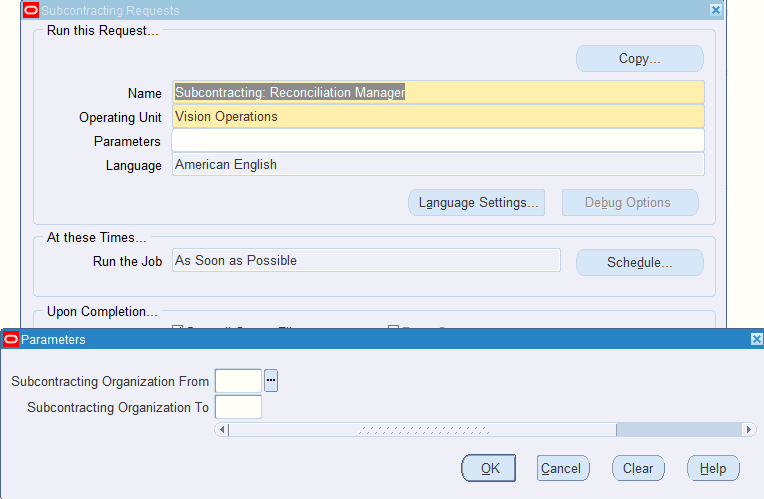
-
Enter the optional Parameters:
-
Subcontracting Organization From
-
Subcontracting Organization To
-
-
Click OK.
-
Click Submit in the Subcontracting Requests window to run the Reconciliation Manager.
Auto Receive Components
The Subcontracting: Auto Receive Components concurrent request performs the following:
-
Selects the shipped replenishment sales orders in the OEM organization based on the MP organization specified in the concurrent request parameters window and creates component receipts for the corresponding purchase orders in the MP organization.
-
Automatically receives subcontracting components into supplier organizations after the predefined in-transit lead time and selects shipped sales orders that are expected to be received in the MP organization after considering the in-transit lead time defined in the shipping networks.
-
Receives drop ship RPOs for internal MPs. For direct ship RPOs, the optional Include Direct Ship RSOs parameter is enabled in the Auto Recieve Components program when users select Internal for MP Organization Type.
If Include Direct ship RSOs parameter is set to Yes the system checks for the quantity partially received, if any, and performs auto receipt of the quantity not received. This would also be applicable for drop ship POs.
Receives all the replenishments sales orders (directship and dropship) for an external MP.
Note: In actual costing organizations, the Auto Receive Components program processes a sales order shipment only once it gets costed by Actual Cost Manager.
-
For Full Outsourcing with External MP in process enabled organizations, the Auto Receive Components concurrent program automatically receives subcontracting ingredients of outsourced products after the predefined in-transit lead time into Manufacturing Partner organization on behalf of Manufacturing Partner. For process organizations, the Auto Receive Components concurrent program:
-
Finds the list of all replenishment sales orders where:
-
The Order status is Booked or Shipped.
-
The Warehouse defined in the header is the OEM organization, and the MP is the customer organization.
-
The Order type is the same as the Order Type defined in Shipping Network between OEM organization and MP organization.
-
If the user has given the concurrent program input parameter organization then it finds associated customer and customer site using the Customer-Supplier relationship in Organization definition. The program considers only those replenishment sales orders which are associated with this customer.
-
-
Searches sales order lines to find cumulative shipped quantity against a combination of customer purchase order, customer purchase order line, and customer shipment number where the warehouse at line level is the same as OEM organization and where the actual shipped date and In-transit Lead Time is lesser than or equal to the current date. It considers In-transit Lead Time corresponding to Default Ship Method from Shipping Network.
-
Finds quantity received against replenishment purchase orders for a combination of customer purchase order, customer purchase order line, customer shipment number, and Unit of Measure (UOM).
-
If shipped quantity is greater than the received quantity, the program auto receives by entering and recording shipped quantity at sales order level records, and received quantity at purchase order level in the receiving transactions interface tables and then runs Receiving Transaction Processor concurrent program.
-
You can run the Auto Receive Components request daily, weekly, or periodically to create receipts of subcontracting components in the supplier organizations.
Note: You can track the status using the Subcontracting Workbench.
To run the Auto Receive Components concurrent request
-
From the Subcontracting responsibility, navigate to the Subcontracting Requests window.
-
Select Subcontracting: Auto Receive Components in the Name field.
-
Click OK. The Parameters window appears.

-
Select from either Internal or External for MP Organization Type.
-
Enter the Manufacturing Partner Organization.
-
Select Yes or No for Include Direct Ship RSOs. Note that this parameter is only enabled if you select Internal for MP Organization Type.
-
Click OK.
-
Click Submit to run the request.
Process Receiving Transactions
The Process Receiving Transactions program is applicable only for external manufacturing partners. Before you run this program, enter component lots using the Component Lot Entry tab in the Subcontracting Workbench for lot based components in external MP organizations. See: Entering Component Lots.
The Subcontracting: Process Receiving Transactions concurrent request:
-
Selects assembly receipts in the OEM organization and initiates WIP job completions and miscellaneous issues to adjust inventory in the MP organization.
-
Processes assembly returns, receipts, return corrections of assemblies, and RMA receipts for components in the OEM organization.
-
For full outsourcing with external MP in process enabled organizations:
-
Selects product receipts in the OEM organization and initiates production batch completions and miscellaneous issues to adjust inventory in the MP organization.
-
Processes product returns, receipts, return corrections of products, and RMA receipts for ingredients in the OEM organization.
-
To run the Subcontracting: Process Receiving Transactions concurrent request
-
From the Subcontracting responsibility, navigate to the Subcontracting Requests window.
-
Select Subcontracting: Process Receiving Transactions in the Name field.
-
Click OK. The Parameters window appears.
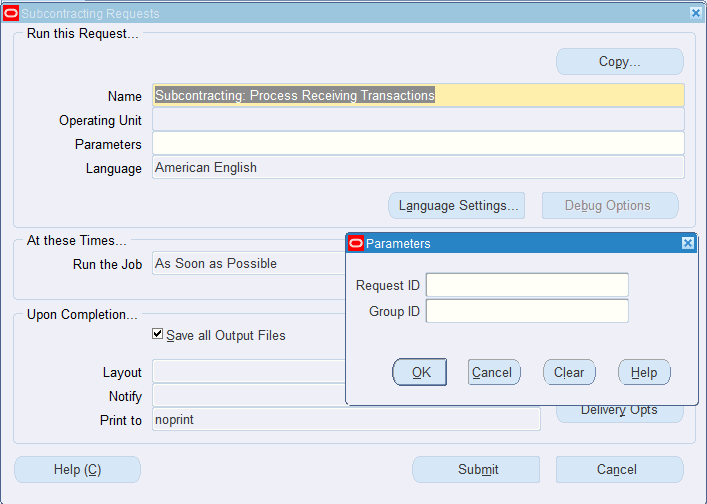
-
Enter an optional Request ID. Valid characters are 0 through 9.
-
Enter an optional Group ID. Valid characters are 0 through 9.
-
Click OK.
-
Click Submit to run the request.
Processing Logic
The Process Receiving Transactions manager picks up the subcontracting order receipts and RMA receipts for replenishment sales orders in the OEM. Then it creates corresponding transactions in the MP organization.
Subcontracting Order Receipts
Receipts are processed only if the following conditions are met:
-
Subcontracting order is fully allocated
-
Subcontracting is not over-received
Tip: The subcontracting order receipt tolerance should be zero so that it will never be over-received.
-
Manufacturing partner is external.
Once the above conditions are met, the Process Receiving Transactions program performs the following:
For discrete manufacturing organizations:
-
Completes the WIP job of the associated subcontracting order in the MP organization and then:
-
Backflushes the components and reduces the component inventory in the MP organization.
-
Moves the completed assemblies to inventory.
-
-
Reduces the completed WIP job quantity in the previous step by miscellaneous issue for the assembly in the MP organization. The offset account defined in the subcontracting options in the shipping network is used for these miscellaneous issues.
-
For actual costing MP organization, the Subcontract PO receipt stays in the OSM Pending status till the work order completion transaction is costed by the Actual Cost Manager. Once the cost becomes available, a subsequent run of Process Receiving Transactions program launches the Receiving Transactions Processor to process the receipt.
For process manufacturing organizations:
-
Completes the production batch of the associated subcontracting order in the MP organization and then:
-
Backflushes the ingredients and reduces the ingredients inventory in the MP organization.
-
Moves the completed products to inventory.
Note: The completion of the batch would be done only after receiving the complete quantity of the purchase order without the receipt tolerances into consideration.
-
-
Reduces the completed production batch quantity in the previous step by miscellaneous issue for the product in the MP organization. The account, derived based on the ADR rules setup under SLA events for the event class Miscellaneous Transactions, is used for these miscellaneous issues.
Subcontracting Order Returns (RTVs)
The Pickup RTV program processes the subcontracting order transactions in the OEM organization and creates the following transactions in the MP organization:
For discrete manufacturing organizations:
-
Increases the inventory of outsourced assembly in the MP organization using miscellaneous receipts, which represent the return of assemblies from the OEM.
-
Creates assembly returns (WIP returns) in the MP organization for the associated discrete jobs, which:
-
Reduces the assembly inventory in the MP organization for returns to the shop floor.
-
Reverses backflushed component transactions.
Note: In internal MP organizations for the return of outsourced assembly items to MP due to quality, non-conformance or any other issues, create RTV manually in OEM against the corresponding RMA transaction in MP organization. For component returns, the steps remain same as external MP organizations.
-
For process manufacturing organizations:
-
Increases the inventory of the outsourced product in the MP organization using miscellaneous receipts, which represent the return of products from the OEM.
-
Creates product returns (WIP returns) in the MP organization for the associated production batch, which:
-
Reduces the product inventory in the MP organization for returns to the shop floor.
-
Reverses backflushed ingredient transactions.
-
Subcontracting Order Receipt and RTV Corrections
The Process Receiving Transactions concurrent request handles receipt and return corrections for subcontracting orders in the OEM. It processes them as WIP completions or WIP returns in the MP organization.
Replenishment Sales Order Returns (RMA Returns)
The Process Receiving Transactions concurrent request selects the RMAs linked to the replenishment sales orders and then creates RTV transactions for the corresponding replenishment purchase order in the MP organization.
Note: Only the RMAs with references to the original replenishment sales order shipped to the MP organization are considered. RMAs without references are not considered for processing.
These steps are performed for accurate simulation of inventory at the MP site.
Remove Allocations
The Subcontracting: Remove Allocations program enables users to remove allocations of components for subcontracting orders. You can remove allocations from an existing subcontracting order/RSO and perform reallocations to another subcontracting order using the interlock manager.
This program only considers unreleased and released work order/flow schedules but with an extent of quantity that is not complete. This program would de-allocate components linked to the specified subcontracting order and enable the next run of interlock manager to perform reallocations.
If no value is specified in the Subcontracting Order or Replenishment SO parameter, the program de-allocates all the components and the next run of the interlock manager would re-allocate the components. Users should run this program followed by the Subcontracting: Interlock Manager program.
The program uses the start and completion date of the WIP job linked to the subcontracting order being processed to ascertain whether the allocations can actually be removed. If the job is already completed, the allocations are left untouched. If the job has started but is not complete, the allocations are removed to the extent of unused quantity. If the job is yet to start, the order is totally de-allocated.
This program is applicable for both internal and external manufacturing partner organizations.
This program is also applicable for full outsourcing with external MP for process manufacturing enabled organizations.
To run Subcontracting: Remove Allocation
-
From the Subcontracting responsibility, navigate to the Requests window.
-
In the Name field, select Subcontracting: Remove Allocations.
-
Click OK. The Parameters window appears.
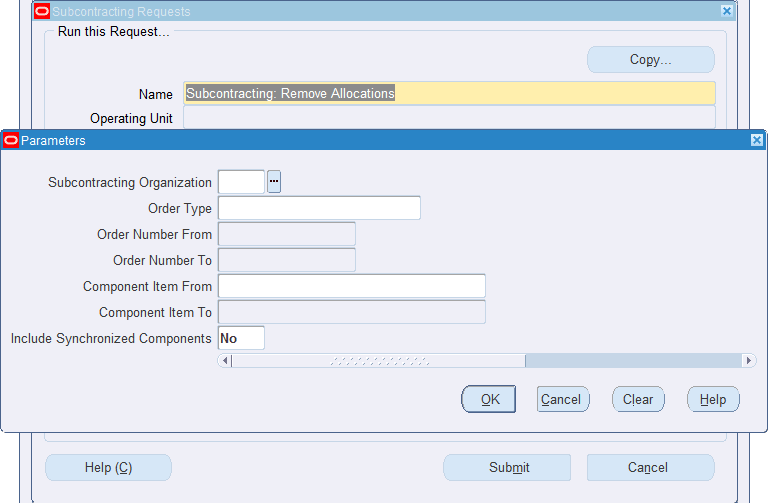
-
Enter information in the following parameters:
-
Subcontracting Organization: Select the OEM organization code. Allocations are removed for those subcontracting purchase orders that have the OEM organization specified in this parameter.
-
Order Type: Select either Subcontracting Order or Replenishment Order.
-
Order Number From: This field is enabled only when users select an Order Type. If the order type Subcontracting Order is selected, enter the first order number for the order number range.
-
Order Number To: This field is enabled only when a value is entered for Order Number From. If the order type Subcontracting Order is selected, enter the last order number for the order number range.
-
Component Item From: Enter the starting item name for the item range.
-
Component Item To: Enter the last item name for the item range. This field is enabled only when users enter a value for Subcontracting Component From.
-
Include Synchronized Components: Select Yes or No. If Yes is selected allocations are removed for synchronized components also. The default value of this parameter is No.
-
-
Click OK.
-
Click Submit to run the request.
Note: It is recommended to run the Interlock Manager after running the Remove Allocation program in order to make the re-allocations. This has to be considered during implementation.